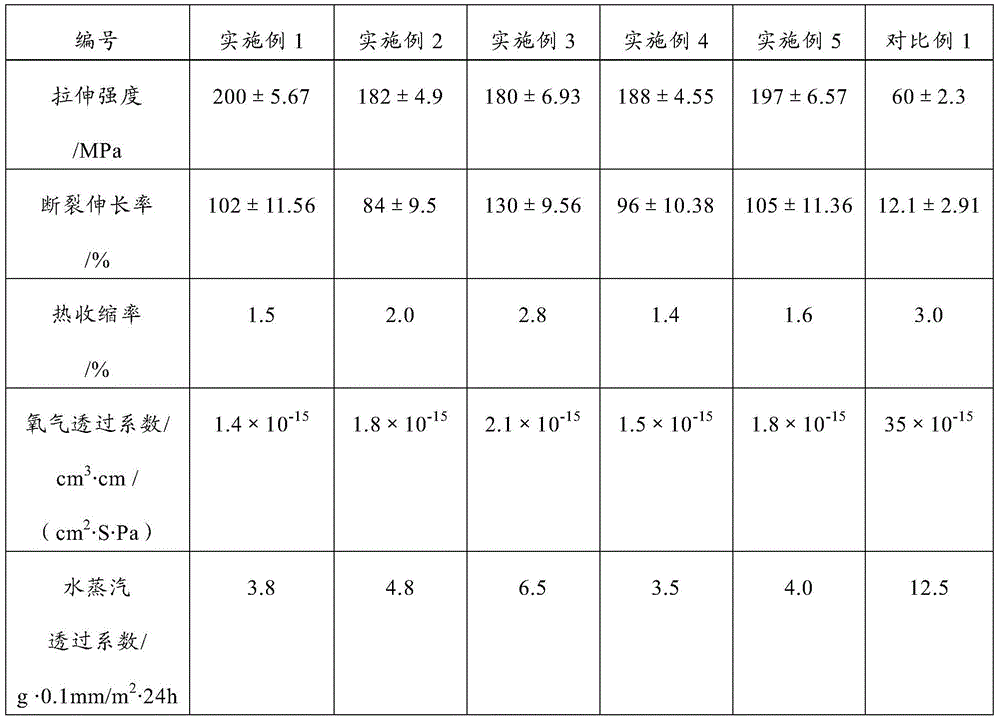A preparation method of nanocrystalline cellulose composite material, products made therefrom and uses thereof
A technology of nanocrystals and composite materials, applied in the field of composite material preparation, can solve the problems of poor performance of polylactic acid/nanocellulose composite materials, poor dispersion of polyethylene glycol/nanocellulose blends, and difficulty in dispersion , to achieve the effect of facilitating continuous production, avoiding easy agglomeration, and shortening operation time
- Summary
- Abstract
- Description
- Claims
- Application Information
AI Technical Summary
Problems solved by technology
Method used
Image
Examples
Embodiment 1
[0028] Take 100 parts of deionized water, 5 parts of nanocrystalline cellulose and 10 parts of polyethylene glycol 600000, put them into a high-pressure homogenizer, and homogenize at 20 MPa for 10 minutes to obtain a dispersion suspension of nanocrystalline cellulose and polyethylene glycol 6000. The dispersed suspension was put into a lyophilizer, and lyophilized at -80° C. under a vacuum pressure of 10 Pa for 8 hours to obtain a blocky solid, which was pulverized into powder by a pulverizer.
[0029] Add the obtained powder and 100 parts of polylactic acid resin to a twin-screw extruder for blending and granulation. The twin-screw extruder is multi-stage temperature-controlled. Speed 30rpm. The obtained particles are dried to remove moisture to obtain a nanocrystalline cellulose degradable composite material. The composite material was taken to prepare a test sample, and its physical and mechanical properties were tested. The test results are shown in Table 1.
Embodiment 2
[0031] Take 100 parts of deionized water, 4 parts of nanocrystalline cellulose and 8 parts of polyethylene glycol 60000, add them into a high-pressure homogenizer, and homogenize at 20 MPa for 10 minutes to obtain a dispersion suspension of nanocrystalline cellulose and polyethylene glycol 6000. The dispersed suspension was put into a lyophilizer, and lyophilized at -80° C. under a vacuum pressure of 10 Pa for 6 hours to obtain a blocky solid, which was pulverized into powder by a pulverizer.
[0032] Add the obtained powder and 100 parts of polylactic acid resin to a twin-screw extruder for blending and granulation. The twin-screw extruder is multi-stage temperature-controlled. Speed 30rpm. The obtained particles were dried to remove moisture to obtain a nanocrystalline cellulose degradable composite material. The composite material was taken to prepare a test sample, and its physical and mechanical properties were tested. The test results are shown in Table 1.
Embodiment 3
[0034] Take 100 parts of deionized water, 3 parts of nanocrystalline cellulose and 15 parts of polyethylene glycol 600015, put them into a high-pressure homogenizer, and homogenize at 20 MPa for 10 minutes to obtain a dispersion suspension of nanocrystalline cellulose and polyethylene glycol 6000. The dispersed suspension was put into a lyophilizer, and lyophilized at -80° C. under a vacuum pressure of 10 Pa for 8 hours to obtain a blocky solid, which was pulverized into powder by a pulverizer.
[0035] Add the obtained powder and 100 parts of polylactic acid resin to a twin-screw extruder for blending and granulation. The twin-screw extruder is multi-stage temperature-controlled. Speed 30rpm. The obtained particles were dried to remove moisture to obtain a nanocrystalline cellulose degradable composite material. The composite material was taken to prepare a test sample, and its physical and mechanical properties were tested. The test results are shown in Table 1.
PUM
| Property | Measurement | Unit |
|---|---|---|
| diameter | aaaaa | aaaaa |
| length | aaaaa | aaaaa |
| diameter | aaaaa | aaaaa |
Abstract
Description
Claims
Application Information
 Login to View More
Login to View More - R&D
- Intellectual Property
- Life Sciences
- Materials
- Tech Scout
- Unparalleled Data Quality
- Higher Quality Content
- 60% Fewer Hallucinations
Browse by: Latest US Patents, China's latest patents, Technical Efficacy Thesaurus, Application Domain, Technology Topic, Popular Technical Reports.
© 2025 PatSnap. All rights reserved.Legal|Privacy policy|Modern Slavery Act Transparency Statement|Sitemap|About US| Contact US: help@patsnap.com

